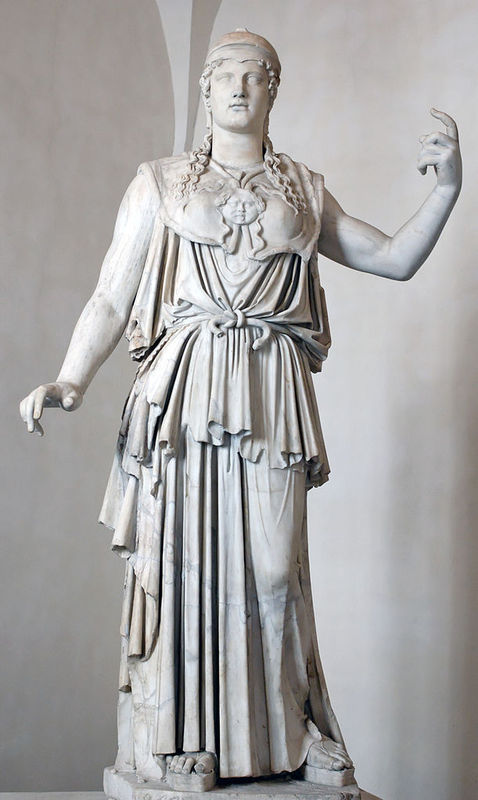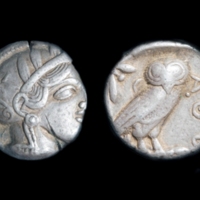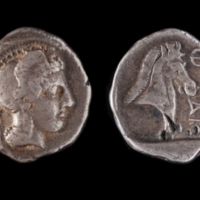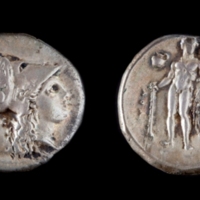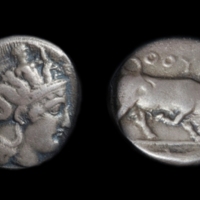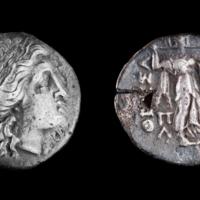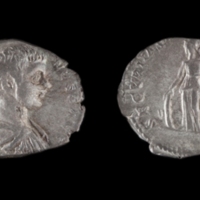Athena: Warrior Goddess
Athena (Latin, Minerva) is one of the most dynamic goddesses of the Hellenistic pantheon. A goddess of war, wisdom and women, she was important enough to be the patroness of Athens and one member of the Roman Capitoline Triad (in which she was worshiped in elaborate temples dedicated to the three main gods: Jupiter, Juno and Minerva).
In the museum’s collection she is pictured with some of her most prominent identifying attributes: a helmet (either Corinthian or Attic depending on the time period), olive leaves, a coiled snake, an owl, and her spear and shield.
The helmet refers to her role as the goddess of war; specifically pertaining to fighting for law and order - as opposed to Ares/Mars’ role as the god of brutal, violent war.
This balanced approach is embodied by both the owl and snake: the owl representing wisdom and the snake representing prudence. Snakes have a bad reputation within a Christian context, but its ancient meaning was one of fertility, healing, and austerity - often occurring as a positive symbol of rebirth. Athenians connected the idea of the snake to their half-snake ancestor, Erichthonios; thus, there were feeling of genealogical pride attached to the snake image as well.
Athena’s very early role as a fertility goddess (possibly replacing an earlier fertility goddess) was probably the source of her association with snakes and thus with the birth of Erichthonios. Hephaestus, in his pursuit of Athena, spilled his semen upon the earth where Athens was being ruled by the early king Kekrops.
Athena scooped up the resulting infant Erichthonios and brought him to the three daughters of Kekrops for safekeeping. Placing him in a basket, she warned the girls never to open it. Of course, curiosity got the better of them and they opened the basket to find several poisonous snakes protecting the boy in the basket. Terrified, they ran to their deaths over the edge of a rocky outcrop on the Athenian acropolis.
It seems that Kekrops adopted this boy as his heir and he eventually became the autochthonous ("born from the land") King of Athens. Interestingly, Kekrops was part snake - bearing the head and torso of a man, but, from hips down, the scaly body of a snake. The kingship of the autochthonous Erichthonios led to the Athenians' belief that they were too born from the same land they lived on, lending them a mythical legitimacy for power.
The olive branch refers to her role as patron goddess of Athens. In a competition with Poseidon, Athena was the first, witnessed by the same Kekrops, to plant an olive tree, cementing the area as her territory.
In the above picture, Athena's aegis, or breastplate, stands in the forefront. This was one of her most prominent features in ancient art and literature. There are two myths explaining how she obtained the Gorgon head for her aegis. One says that Perseus gave Athena the head of Medusa after he slew the monster. Another story, accounted in Euripides' Ion (line 995), says that Athena slew the gorgon herself during the Olympians' fight with the giants, also known as the Gigantomachy. It has been suggested that Euripides is referencing an older version of the myth, now mostly lost within other Hellenistic literature.
References:
Hall, James. 1974. Dictionary of Subjects and Symbols in Art. New York: Harper & Row. p. 209-210, p. 285-286.
Burkert, Walter. 1985. Greek religion. Cambridge, Mass: HarvardUniversity Press.
Gantz, Timothy. 1993. Early Greek myth: a guide to literary and artistic sources. Baltimore: JohnsHopkinsUniversity Press.
